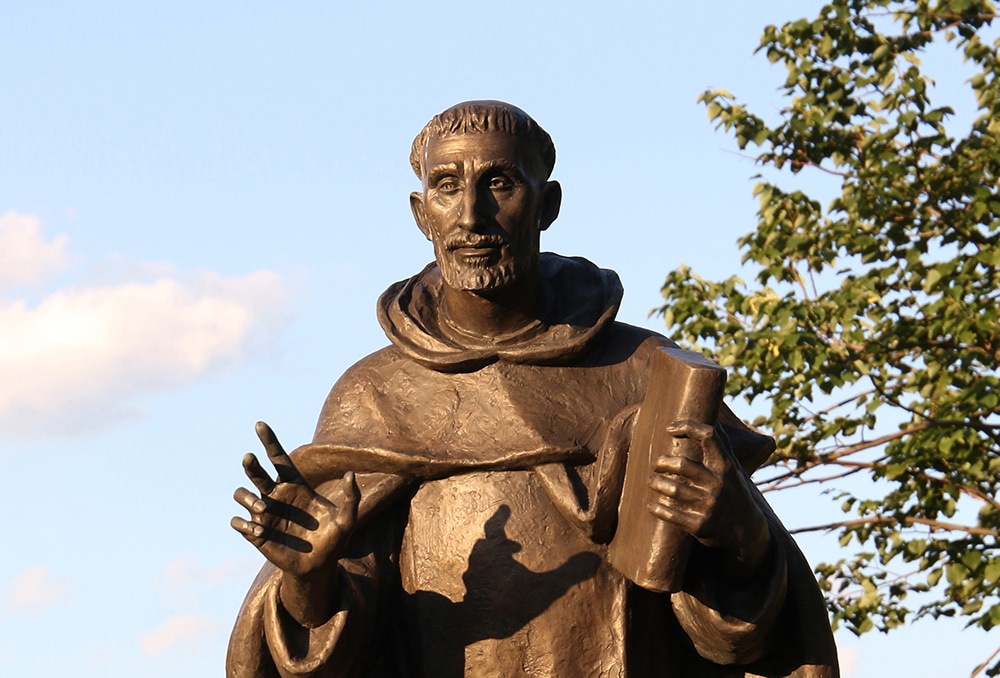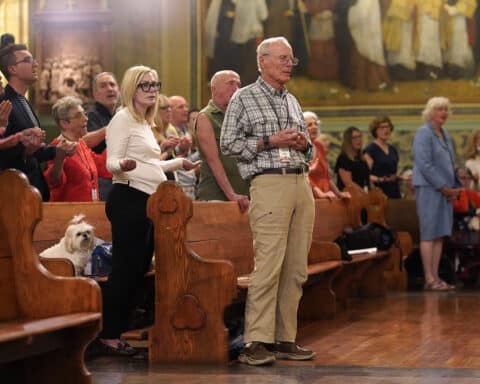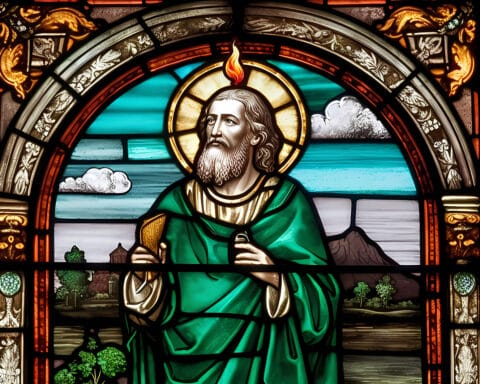If you could learn to pray like your favorite saint, would you? That’s a question I’ve asked myself over the years as a Catholic convert who is now in formation as a lay Dominican. Praying like a Catholic at all, once upon a time, made me shiver. Then it became the only acceptable way. And as I learn about my great patron, St. Dominic, and have come to an appreciation for the form of prayer that the Order and other tertiary members have shared, I’ve sought more understanding of the particulars of Dominic’s prayer.
Not knowing much about Dominic other than some basic life details and that he formed an order with the purpose and intent on preaching and defeating heresy, I’ve conversed with Dominicans worldwide and collected numerous rare books to satisfy my hunger to know this saint. The history of the Dominicans is together embarrassing and admirable. It’s one of the Order’s inside jokes that significant effort has never been placed on good record keeping. Read any knowledgeable source on the history of the Rosary, for example, and you’ll soon see there are regrettable gaps in proving the tradition that Mary blessed Dominic with this prayer and mysteries.
However, one blessing of the information age is the excellent catalogue of documentation and manuscripts that one might never have access to otherwise. Hagiographers of St. Dominic express his prayer in narrative form. For example, they will tell of how he would pray all night until morning, or approach a city and always pause to weep in prayer for the sins of the townspeople, or how he would refuse to enter an inn on any journey until he had exhausted himself in prayer in the nearest church. These are wonderful details, but in the last century or so, scholars and authors have discussed a manuscript discovered in the Vatican library that details the “nine ways of prayer of St. Dominic.”
Others have survived in what appears to be a well-copied instruction book and treatise, perhaps originally written between 1260 and 1288 when the first archives of the Order were approved some 40 years after the death of the saint in Bologna, Italy. Complete with pictures, annotation and directions, there is little doubt to scholars that when reading this, we are in direct contact with Dominic — like a fly on the wall of those closed chapel doors where he hid himself for hours (sometimes discovered by his brothers). As we prepare to celebrate the feast St. Dominic on Aug. 8, here are the nine ways he prayed, according to this manuscript, the Codex Rossianus 3.
Postures, poses and habits
1. Before it was common, each time Dominic would pass by an altar, he would bow. He would make a solemn bow also before any crucifix, uttering no words, only contemplating his own unworthiness of the paschal sacrifice.
2. His second way was to lay prostrate, many times on the ground of the earth, to weaken and humble himself. His prayer in this position, when heard: “God, be merciful to me, a sinner.” He often told his followers that if they have no sins to repent of, to repent for the sins of those in the world and the souls in purgatory.
3. Typically following this, the third way of his prayer was to strike himself on the back, either with a chain, or a rod, or a branch. He wished to endure suffering with Christ for his sins and those of the world. Well known and well-imitated was this practice, such that it was mandated for a time by the Order.
4. His fourth way was to stand before the altar or in the Chapter Room, kneeling and rising to his feet over and over again as he looked upon the crucifix. His movements were orderly and rapid, ignoring any pain involved. He recalled the words of the leper who said, “[I]f you wish, you can make me clean” (Mk 1:40). There were times when his gaze would not leave the crucifix and he would begin crying with immense joy in the consolation of God’s mercy.
5. In the fifth way, Dominic would stand and hold his hands in front of his chest, palms outward, fingers together and upward as he prayed or read quietly. Other times, he would bring his hands together before his brow, hunching a little. On occasion, he would also fix his hands above his shoulders near his ears, as if to better listen to a certain sound.
6 In the sixth way, he would often throw his arms out to either side in a position that reflected the crucified Christ. Oftentimes, he made these gestures in public without a care of his appearance, sometimes crying loudly during Mass, but almost always using this form prior to a miracle he would perform — including the famous resurrections and rescuing of pilgrims from drowning.
7. One of the more distinctive ways of his prayer, the seventh, was his way of making a sort of arrow from his body, stretching himself skyward to heaven. He would do this while teaching or even reprimanding the brothers of the Order, but never for long. He instructed them with the words of the psalmist: “O come, bless the Lord, / all you servants of the Lord. … / Lift up your hands toward the sanctuary, / and bless the Lord” (134:1-2).
8. Dominic’s eighth way was also a bit distinctive. He could be observed, after a meal or the prayers of a liturgical hour, going away to a desk with a selected reading. There, he would read and converse with himself, asking theological questions and even conceive arguments on matters of life and the Faith. He would move from this to a silence of meditation, and further to a silence of contemplation. There were moments when the saint would hide his face in his scapular, weeping or giggling. In all cases, Dominic would complete his study by a gentle bow and kiss the text of whatever he was reading. His instructions to his followers were the same: study in prayer.
9. The final way of his nine had to do with his near constant adventures. He travelled on foot between Spain, France and Rome on several occasions, stopping in locations such as Citeau, Venice and Bologna to recruit and train new chapters. Traversing perhaps 12 miles by foot each day for many of the years of his life, he would have to improvise in the absence of a church. So then, he would wander off from his companions, either ahead or behind, to converse with God, always rejoining the group with a fire enkindled inside him.
Applying his lessons today
These are the ways of prayer of St. Dominic, and after reading more than 10 separate accounts of his life, these seem to both agree with what I’ve read and create more questions. Of all the things that I’ve found to be drastically different about his life and the world he lived in, it has been his form of prayer.
It’s clear that Dominic was a highly habitual man in prayer, but it’s clear he intentionally incorporated his body into that prayer as well. Imagining him mortifying his flesh, or causing some distraction during Mass with his gestures can be an honest moment to wonder if I have the courage to join with my body in prayer as he did.
Contemplating his total devotion to God in a meeting between his body and conscience has furthered my wonder as whether or not we are challenged to truly release ourselves in prayer in modern times. I feel as if our modern milieu might be so wrapped in the image we have of good prayer — stable, articulate, with good posture — that we aren’t willing to express ourselves in such ways. His form of prayer seems almost unacceptable in our times, though I’m not sure it should be.
Shaun McAfee writes from Italy.





